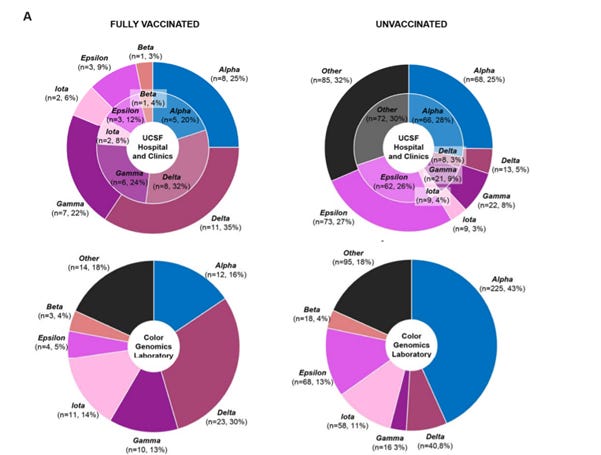Omicron – A variant of concern for the vaccinated
The first cases of Omicron variant were detected in fully vaccinated people in Botswana.
The first footballers to be infected were also fully vaccinated.
The first person in the US detected with Omicron, the same - fully vaccinated.
One might argue that is because there is a high percentage of vaccinated persons but that doesn’t work for Africa. Just a chance happening that they are all vaccinated, then?
Several papers were hinting at an answer to that question and one in particular worth mentioning is Predominance of antibody-resistant SARS-CoV-2 variants in vaccine breakthrough cases from the San Francisco Bay Area, California published in August 2021 by Servelitta et al. Largely unnoticed and therefore hiding potentially important clues of Sars-Cov-2 variants.
Figure 1 below shows pie charts depicting the percentages of variants among vaccinated and unvaccinated people. I want to draw your attention to the top row first. Look at the top left pie chart and note the percentage of Delta variant in the vaccinated cohort. You’ll find it is 35%. Now compare that to the percentage in the unvaccinated (top right)– 5%. Of course, these are small sample sizes but it is different. Now compare the lower pie charts, with data from another source. The vaccinated have a 30% distribution of Delta; and the unvaccinated have 8%, with a bigger sample size.
That gives a clue that as the new variant, in that case, Delta, is entering the affray, it may have a predilection for the vaccinated compared to the unvaccinated.
Fig.1 Variant distribution of vaccinated and unvaccinated
The distribution of SARS-CoV-2 variant lineages in fully vaccinated and unvaccinated cases from UCSF Hospitals and Clinics (top) and from Color Genomics Laboratory (bottom). In the UCSF charts, the inner circles represent the immunocompetent cases, and the outer circles include both immunocompetent and immunocompromised individuals. From Predominance of antibody-resistant SARS-CoV-2 variants in vaccine breakthrough cases from the San Francisco Bay Area, California
We cannot, of course, based solely on that data, declare it as a proven hypothesis but it is an interesting observation, nonetheless.
Move forward three months, though, and the release of a paper by Andeweg et al. from the Netherlands entitled Increased risk of infection with SARS-CoV-2 Beta, Gamma, and Delta variant compared to Alpha variant in vaccinated individuals
Those researchers wanted to address the extent to which variants of concern contributed to breakthrough infections in vaccinated; and previously infected groups. What they found supports the Servellita paper.
Here, we analyze 28,578 sequenced SARS-CoV-2 samples from individuals with known immune status obtained through national community testing in the Netherlands from March to August 2021. We find evidence for an increased risk of infection by the Beta (B.1.351), Gamma (P.1), or Delta (B.1.617.2) variants compared to the Alpha (B.1.1.7) variant after vaccination. [My emphasis].
They noted that the effect was larger in the first 14-59 days after complete vaccination compared to 60 days and longer.
More importantly, they discovered that was not the case for the previously infected:
In contrast to vaccine-induced immunity, no increased risk for reinfection with Beta, Gamma or Delta variants relative to Alpha variant was found in individuals with infection-induced immunity. [My emphasis].
Figure.2 Odds Ratio for infection by variants for previously infected and vaccinated
Comparison of variants infection in previously infected; partially vaccinated; and fully vaccinated subjects. From Increased risk of infection with SARS-CoV-2 Beta, Gamma, and Delta variant compared to Alpha variant in vaccinated individuals
As we can see from Fig. 2 (above) the previously infected breach the 1 line and are thus not significantly associated with an increased risk of infection with newer variants compared to the original strain; but the vaccinated mainly are.
If new variants are infecting, asymmetrically, the vaccinated compared to the unvaccinated, then why would that be?
We may be seeing these immunological mechanisms at work here.
1. Immune training, where for example the Innate immune system in the unvaccinated is adapting to the everchanging Sars-Cov-2 variants via evolutionary epigenetic control mechanisms and better able to defend itself against infection.
2. The vaccinated undergoing immune tolerance after vaccination, via attenuated toll-like receptor function, Induced by altered mRNA coding in the mRNA vaccines. Adding to their risk of infection by new variants.
3. Hyper-specificity of the adaptive immune system out-competing the broad based innate immune system, as a result of vaccination. Leaving the vaccinated open to variant infection.
Nb. More complex mechanisms are also present, for example, short-lived immature IgG antibodies out competing innate antibodies.
In summary, the scientific literature we have discussed suggests that Sars-Cov-2 variants may have a predilection for the vaccinated. And the above data, in addition to mounting evidence challenging the accepted narrative that the unvaccinated pose a greater risk than the vaccinated, suggest it is now time for that narrative to cease, as it simply does not comport with the current understanding of Sars-Cov-2 and established immunological mechanisms.


